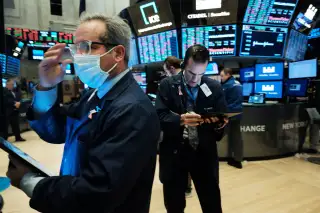What a Second Round of Coronavirus Lockdowns Would Mean for the Stock Market

So far the stock market has remained surprisingly sanguine in the face of the economic and human toll of COVID-19. Now as new virus hotspots emerge in the U.S., investors are having to reassess.
Even with stay-at-home orders, a total of 47 million jobless claims, and a national death toll of 124,000 and rising, the S&P 500 is actually down only 6% year-to-date. From the lows of March 23, it is up almost 40%.
Part of that positivity stems from expected curve-flattening, that much of the world has experienced. As societies and businesses gradually reopen, economic engines can rev up once again.
In the U.S., however, the virus is showing no signs of burning out. With a new record of 38,762 positive tests on June 24, the viral chart implies a second wave – or, rather, a first wave that never really ended.
So that begs the question: If another set of lockdowns proves necessary, in new hotspots like Texas, Florida, Arizona or California, what does that do to economic projections – and, in turn, stock values?
“It’s clear to me that we’re not going back into a national lockdown, but what people should expect are rolling periods and rotating areas of reopening phases,” says David Rosenberg, founder and president of Toronto’s Rosenberg Research.
“No doubt that will hold back our recovery, which is what has undermined the market in recent sessions. Large states like California and Texas and Florida are a huge chunk of national GDP, so that is a clear negative that will impair recovery in the third quarter.”
For equity investors, it’s like playing a game of 3D chess. Stock-picking is a challenging business at the best of times: But now investors are operating in an environment where new data is coming in by the minute, states are tweaking directives almost every day, and the usual metrics like forward price-to-earnings ratios are so foggy as to be almost unusable.
“The economic picture has been gradually improving, with greater spending and investment,” says Gregory Daco, chief U.S. economist for analytics firm Oxford Economics. “But the situation is evolving very rapidly, much more rapidly than we have ever been accustomed to. And we are starting to see worrisome signs of a stalling in economic activity, due to a renewed rise in cases.”
Lockdown redux?
One way to deal with those climbing numbers, of course, would be to go back into some version of lockdown. Texas, for instance, has paused its reopening as it grapples with record cases, and its hospital systems strain near capacity.
But the public appetite for stay-at-home measures, after months of Americans going stir crazy, seems close to nil. And states vary so wildly in their experiences – New York and New Jersey have already gone from “basket cases” to “beacons of success,” says Rosenberg – that broad national directives may not be applicable.
What is more likely is a patchwork system of local response, and stepped-up promotion and enforcement of partial measures like mask-wearing and social distancing. All of which will help, but economies won’t really be let loose until the “Big Kahuna” of a vaccine eventually comes along, says Rosenberg.
So what does all this mean for equity investors? While a continued caseload is obviously not our hoped-for outcome, neither is it necessarily a sign to flee for the market exits. That is because lockdown measures, as we learned from the initial wave, don’t automatically mean a dearth of economic activity.
There is a shift in how and when consumers spend, to be sure -- but it doesn’t necessitate that everything grinds to a halt. “There is a general misunderstanding that the contraction of economic activity was due to lockdown, but that has been proven wrong,” says Daco. “The evidence shows that was not the case.”
Also remember that the stock market is never a perfect reflection of the economy. For instance, in this case, equities have indirectly been supported by massive intervention from the Federal Reserve: Historically, stocks are an attractive place to be during eras of low interest rates, since bonds return almost nothing in comparison. And U.S. is still seen globally as a safe haven for assets, as funny as that may sound at the moment.
What to expect next year
Of course, not all stocks are created equal, especially in such a unique moment as this. The market has essentially “bifurcated,” says Rosenberg: Some sectors – tech, consumer staples, homebuilders, healthcare – are breezing along quite nicely. Others are feeling real existential pain – such as financials, insurance companies, and vulnerable small-caps.
Longer term, the outlook is brighter than you might think. Chicago-based research firm Morningstar projects a 5.1% U.S. GDP drop for 2020, followed a robust 5.6% recovery in 2021. Long-term by 2024, it expects only a 1% GDP hit compared to pre-Covid expectations.
What seems clear is that after such a quick snap-back from March lows, we can now expect a slower and bumpier recovery for the market going forward. With the playing field constantly shifting under our feet, it’s hard to draft a consistent playbook – because tomorrow you might need an entirely new one.
“In times like this, forecasters have to be humble,” says Daco. “You have to know what you don’t know.”
More from Money:
'COVID Is Different': How Coronavirus Upended the Rules of Investing in a Recession
The Fed Plans to Keep Interest Rates Near 0% Through 2022. Here's What That Means for Retirees